You don't have to do that much to get a handsome gooseberry harvest. You can find out what needs to be considered when planting, caring for and harvesting here.
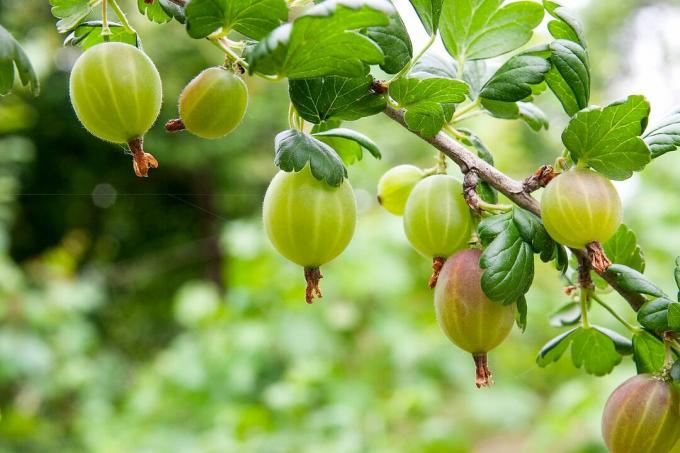
The gooseberry (Ribes uva-crispa) has been used since 15. Cultivated in Europe in the 17th century. It was already very popular in England at that time, where it is also called “gooseberry” (in English “gooseberry”). Like the red one currant (Ribes rubrum) it also belongs to the gooseberry family (Grossulariaceae). From the old name Ribes grossularia Incidentally, the popular name “Ogrosl” comes from Austria. As the name suggests, the shoots of the berry bush are very prickly. Strictly speaking, however, the gooseberry should be called “thornberry” because its supposed spines cannot be broken off, as is the case with thorns.
contents
- Buy gooseberry
- Gooseberry varieties: a selection
- Plant gooseberry
- Propagate gooseberry
-
Caring for gooseberries
- Pour gooseberry
- Fertilize gooseberries
- Transplant gooseberry
- Cut the gooseberry
- Harvesting gooseberries: when is harvest time?
-
Store gooseberries
- Freeze gooseberries
- Reduce the gooseberries
- Gooseberry Diseases
Buy gooseberry
The gooseberry fruits taste sweet and sour and have a firm, hairy skin. The berries are also very healthy and contain many minerals such as potassium and phosphorus. Supermarkets offer the fragrant berries as opposed to Strawberries (Fragaria), Raspberries (Rubus idaeus) and blueberries (Vaccinium) but only very rarely. That is why we can only recommend that you plant the gooseberry in your own garden.
When buying young plants, you should pay attention to the right choice of variety. American gooseberry powdery mildew has unfortunately caused great damage to crops in recent decades, and as a result the gooseberry has also lost its importance in home gardens. However, there are now many excellent powdery mildew-resistant varieties to buy. Gooseberry fruits come in red, green and yellow colors. The taste can also vary from variety to variety. If you plant early, medium and late ripening varieties, you can also extend the harvest time. In areas at risk of frost, however, it is better to use late-blooming varieties in order to avoid crop failures.
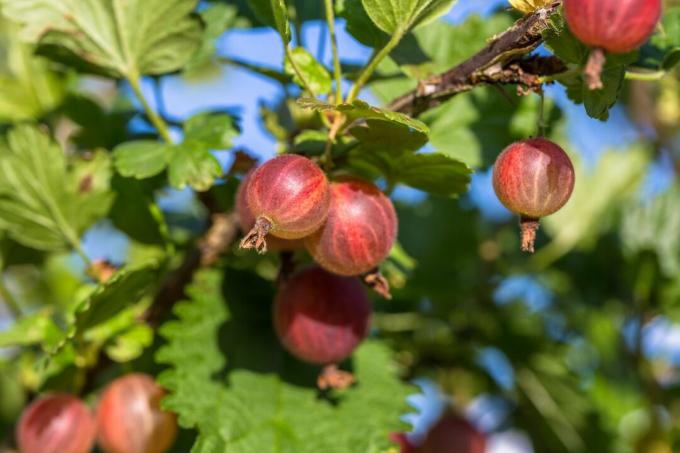
By the way, if you are looking for a real eye-catcher, a refined gooseberry tree could be something for you. These are often used for the design of gardens. The cultivation of Josta berries (Ribes × nidigrolaria) - a cross between species Black currants (Ribes nigrum) and gooseberries - is becoming increasingly popular in the home gardens.
Gooseberry varieties: a selection
There is a wide variety of different gooseberries to choose from. These differ in fruit color, fruit hairs and reinforcement (expression of the thorns). In addition, the beginning of flowering and the time of ripening can be important criteria for choosing a variety. Here is a small selection of the best gooseberry varieties:
'Invicta': Green, medium-sized fruits with highly translucent veins; upright growth; very early ripening (from mid-June); high and safe yields; only short thorns on the shoots; low susceptibility to mildew
'Green Hansa' (also 'white triumphant berry'): Mid-early harvest possible from the beginning of July; frost-resistant variety with high yields; medium susceptibility to powdery mildew; strong reinforcement; large, slightly hairy fruits with a fine aroma; however, the berries brown a lot during processing
'Green ball' ‘: High-yielding variety with a medium ripening period; produces large fruits with a greenish-white color; sweet and sour taste; the fruits tend to burst, but hardly turn brown when processed; very susceptible to powdery mildew and winter cold damage
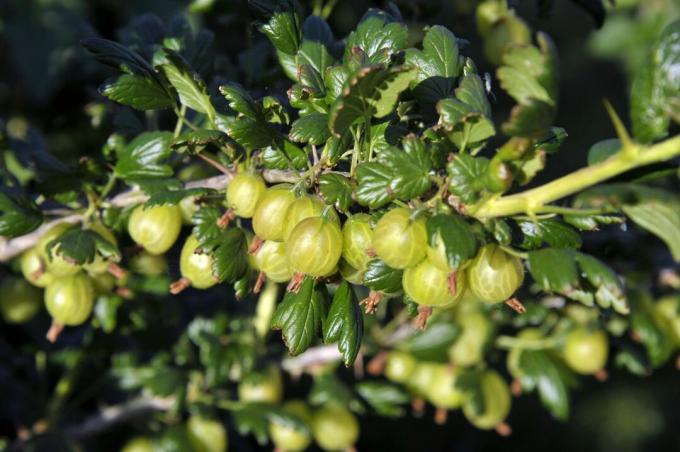
'Red Triumph' (also 'Winham’s Industry'): Old English variety; medium early flowering and maturity; regular and very high yields; very strong reinforcement; large fruits with a dark red color; densely downy hairy with thick skin and very good aroma; robust variety, but powdery mildew infestation possible
'Rokula' / 'Rocula': Early harvest possible; the shoots are strongly reinforced; round, black-red, medium-sized fruits; very sensitive to bursting due to the delicate shell; resistant to powdery mildew
'Yellow Triumphal Berry' (also 'Triumphant'): A high-yielding variety with medium-early ripeness; produces medium-sized, pale yellow fruits; sweet taste, but not very aromatic; strong clearing necessary, otherwise tendency to small fruitiness; well suited for processing
'Pax': Early variety with strong growth; good pickability due to the low reinforcement; large, medium-red fruits with little hair; prone to sunburn; resistant to powdery mildew and leaf fall
An extensive collection of Gooseberry varieties and more detailed information on the individual varieties can be found here.
Plant gooseberry
The gooseberry grows on medium-heavy, nutrient-rich and well-aerated soils. Our Plantura Organic tomato & vegetable soil is ideal for planting soft fruit. The location requirements are similar to those of currants, but gooseberries need more moisture. Protected locations are preferable due to the flowers' sensitivity to frost. Partially shaded locations are ideal for gooseberries, because sunburns occur more frequently on the fruits in sunny locations.
The best time to plant new gooseberry bushes is in autumn (October / November) in order to use the winter moisture of the soil for growth. The introduction of compost or rotted manure into the planting hole offers the plant an ideal start-up aid. Despite self-pollination, you can encourage cross-pollination by placing different varieties side by side. In doing so, however, you should ensure that there is sufficient distance between the plants.
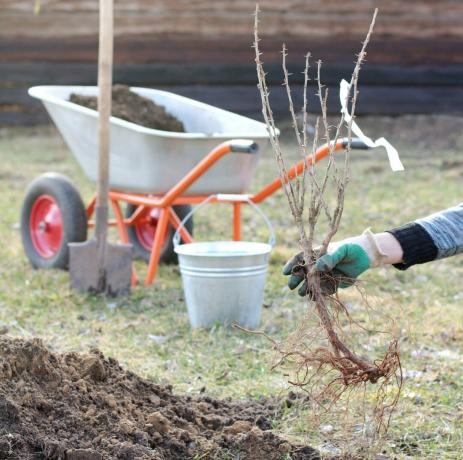
More information and instructions for the Planting gooseberries can be found in our special article.
Propagate gooseberry
If you don't have enough gooseberries in your own garden, you can easily propagate them yourself using cuttings or demolitions.
- Cuttings: In the spring, cut off annual shoots about 30 cm long and insert them into the soil so that only two to three buds are sticking out. The new plants form roots very quickly and you can then transplant them to a desired location.
- Sinker: A long shoot is bent down, fixed to the ground with a stone and covered with earth. The tip of the shoot should still look out of the ground and can also be tied to a small stake. As soon as the new shoot has developed enough roots, you can separate it from the mother plant.
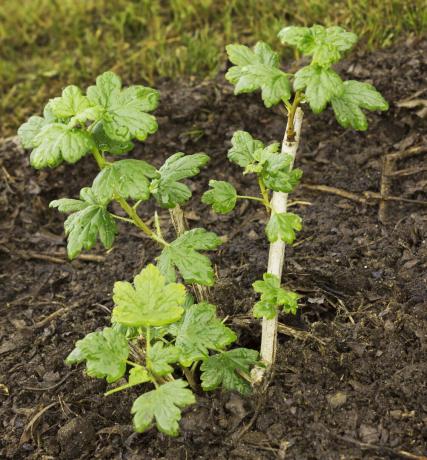
Caring for gooseberries
In order for the gooseberries to produce a bountiful harvest, they must be well cared for. We have summarized the most important information about the care of this plant for you below.
Pour gooseberry
Gooseberries enjoy plenty of water, especially during the ripening period. Regular watering is therefore recommended to bridge dry periods. Drought stress can quickly lead to small fruits in the plant, premature fruit fall or even to bursting of the fruits.
Fertilize gooseberries
In order for the gooseberry to thrive, it must absorb sufficient nutrients from the soil. For the Fertilizing your gooseberry you can use organic universal fertilizers - like our Plantura Organic universal fertilizer - Use special berry fertilizers or natural fertilizers from the garden such as compost or lawn clippings. The use of organic fertilizers has the advantage that the nutrients are only released gradually and are available to the plant. This means that there is only a low risk of over-fertilization and leaching of nutrients into deeper soil layers or the groundwater.

Organic fertilizers - such as garden compost or rotted manure - should be used in late autumn should be applied so that the nutrients it contains take effect in time for the growing season in spring can be. Above all, gooseberries need sufficient potassium for a rich fruit stock, which is why suitable berry fertilizers should always contain an appropriate proportion of this nutrient. The strongest growth takes place between mid-April and the end of May, so the main fertilization should be done in early spring. In addition, you can also cover the soil around the gooseberry plant with a layer of mulch made from lawn clippings.
Tip: Our Plantura Organic universal fertilizer is mainly made from organic raw materials and, due to its composition, is ideally suited for the long-term supply of nutrients to berry bushes.
Transplant gooseberry
Transplanting the gooseberry is still possible after a few years. The best time for this is in autumn (October / November), when the plant is in the dormant phase, but you can also move the berry bush in spring. However, the ground should already be thawed and on the day of implementation it is advisable that there are as little freezing temperatures as possible. Since a lot of root volume is lost when moving, it is also advisable to cut back the plant by about a third above ground. Then dig up the plant widely and loosen the root ball from the earth. So that the plant is well taken care of at its new location and can recover from the stress of moving, some organic material (such as compost) should be incorporated into the planting hole will. In addition, do not forget to water the new plant well in the beginning and, if necessary, apply a layer of mulch.
Cut the gooseberry
When you cut the gooseberry, you should ensure that it is easy to pick and that it is clearly arranged. It is best to cut in the autumn after the harvest or in the dormant phase in winter from December to mid-February. With an additional thinning of the shoots in May, the remaining fruits become larger.

In our special article we show you what the Cutting the gooseberry arrives exactly.
Harvesting gooseberries: when is harvest time?
The fruits of the gooseberry are - as with the currants and blueberries - actually a berry in the botanical sense. Depending on the variety, they can be harvested from the beginning of June to August. With a relaxed upbringing, you avoid bloody hands due to scratches during the harvest. Since the gooseberry is very sensitive to late frost, the harvest yields can vary greatly from year to year. Depending on the variety, age and site conditions, the yield is around 3.5 to 4.5 kg per bush.
For fresh enjoyment, you should only harvest the fully ripe fruit. Remember, however, that the fruits ripen and can only be kept in the refrigerator for about ten days. Most varieties can be harvested twice with an interval of 10 to 14 days. Fruits of varieties that are susceptible to space should be harvested in an immature, green state (i.e. at the end of May / beginning of June) for preservation.

Store gooseberries
In addition to being extremely healthy to eat raw, gooseberries are also ideal for cakes, compotes and other desserts, as well as for preserving and making jams. However, since the gooseberries ripen in a very short period of time and the fruits have a limited shelf life in the refrigerator, you should definitely remember to preserve the berries.
Freeze gooseberries
Freezing is a simple way of preservation. Whole or pureed, with or without sugar - the method of freezing ultimately depends primarily on the intended use. If you want to freeze whole fruits for a cake, there is a risk of them bursting due to the high water content. It is therefore advisable to harvest the berries shortly before they are ripe. It is best to briefly blanch the gooseberries in hot water and place them as close together as possible in freezer bags or suitable plastic containers.
Reduce the gooseberries
You can easily make jams or jellies from gooseberries. To do this, the berries are first washed and boiled in a little water until they burst, then strained and boiled down with sugar. Depending on the gooseberry variety, a green, yellow or red jelly is created. This is filled into glasses while still hot and sealed airtight. Unopened, the jelly can be kept for at least one year if stored in a cool, dark place.
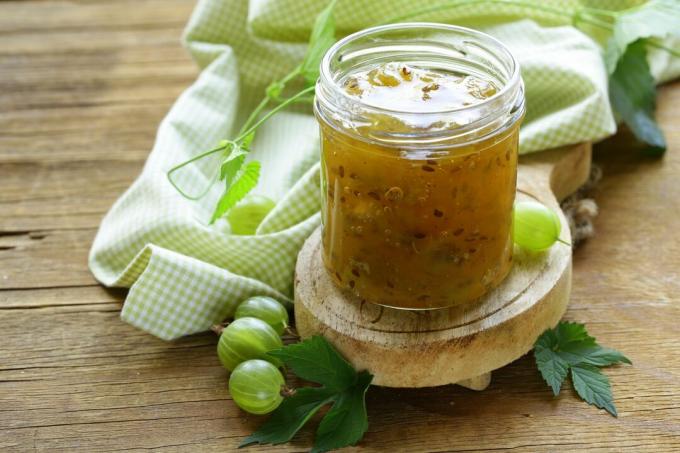
Further information and helpful tips on Preservation of gooseberries You will find here.
Gooseberry Diseases
Many diseases and pests of the gooseberry resemble those of the currant. Fortunately, gooseberries are very hardy and you rarely need to intervene. The following pathogens could become a problem for your gooseberries:
American gooseberry powdery mildew (Sphaerotheca mors uvae)
White-coated shoot tips and curved, small leaves are the hallmarks of an attack by this fungus. In addition, unripe fruits can also be attacked. When choosing the variety, you should therefore pay attention to its resistance to powdery mildew. The 'Invicta' and 'Pax' varieties, for example, are characterized by a low susceptibility to mildew. Should you nevertheless notice infected shoots, we recommend that you remove them as soon as possible to avoid spreading. Do not dispose of the infected plant material on the compost, but in the garbage can.
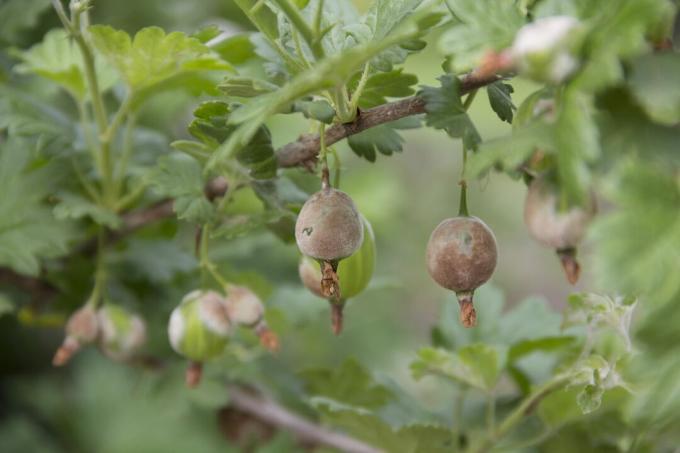
Leaf fall disease (Drepanopeziza ribis)
If the plants lose a large part of their leaves during or after the harvest, it is very likely that it is so-called leaf fall disease. On the upper side of the leaf, there are small, brownish-gray spots that grow together over time. The leaves turn yellow, curl up and fall off. The early leaf fall occurs especially in wet years and weakens the plant. Moist, slowly drying places are therefore not suitable as a location for the gooseberry.
Gooseberry sawfly (Pteronidea ribesii)
This pest occurs exclusively on gooseberries and josta berries. If the leaves of individual bushes are missing from one day to the next, this can be an indication of the massive infestation with sawfly caterpillars. These are about 18 mm long, greenish in color and covered with dark warts. Several generations develop within a very short time (three to four per year). Regular checks for caterpillars in the spring are therefore useful. If there is actually an infestation, selective control with insecticides is sufficient.



